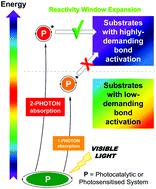当前位置:
X-MOL 学术
›
Org. Chem. Front.
›
论文详情
Our official English website, www.x-mol.net, welcomes your
feedback! (Note: you will need to create a separate account there.)
Recent applications of biphotonic processes in organic synthesis
Organic Chemistry Frontiers ( IF 4.6 ) Pub Date : 2020-06-02 , DOI: 10.1039/d0qo00466a Jorge Castellanos-Soriano 1, 2, 3, 4 , Jorge C. Herrera-Luna 1, 2, 3, 4 , David Díaz Díaz 5, 6, 7, 8, 9 , M. Consuelo Jiménez 1, 2, 3, 4 , Raúl Pérez-Ruiz 1, 2, 3, 4
Organic Chemistry Frontiers ( IF 4.6 ) Pub Date : 2020-06-02 , DOI: 10.1039/d0qo00466a Jorge Castellanos-Soriano 1, 2, 3, 4 , Jorge C. Herrera-Luna 1, 2, 3, 4 , David Díaz Díaz 5, 6, 7, 8, 9 , M. Consuelo Jiménez 1, 2, 3, 4 , Raúl Pérez-Ruiz 1, 2, 3, 4
Affiliation

|
Currently, evolution of chemical transformations by visible light irradiation is highly desirable from cost, safety, availability, and environmental friendliness points of view. Besides, activation of less reactive substrates under very mild conditions becomes one of the most challenging tasks in organic synthesis. However, the insufficient energy provided by one photon of visible light for their activation definitely makes necessary the development of new protocols together with the design of new photocatalytic systems to overcome this limitation. In this context, the implementation of biphotonic processes has been found to be a solution for these drawbacks. This new mechanistic paradigm which combines light upconversion processes with energy/electron transfers holds great potential for high energy demanding bond activations, expanding the accessible reactivity window. Here, we wish to highlight the recent applications of biphotonic processes in organic synthesis.
中文翻译:

双光子过程在有机合成中的最新应用
当前,从成本,安全性,可用性和环境友好性的观点来看,非常希望通过可见光辐射来化学转化。此外,在非常温和的条件下活化反应性较低的底物成为有机合成中最具挑战性的任务之一。然而,由一个可见光的光子提供的不足以激活它们的能量无疑使开发新协议以及设计新的光催化系统来克服这一局限性成为必要。在这种情况下,已经发现双光子工艺的实现是这些缺点的解决方案。这种将光上转换过程与能量/电子转移结合在一起的新的机械范式,对于高能量要求的键活化具有巨大的潜力,展开可访问的反应窗口。在这里,我们希望强调双光子过程在有机合成中的最新应用。
更新日期:2020-06-30
中文翻译:

双光子过程在有机合成中的最新应用
当前,从成本,安全性,可用性和环境友好性的观点来看,非常希望通过可见光辐射来化学转化。此外,在非常温和的条件下活化反应性较低的底物成为有机合成中最具挑战性的任务之一。然而,由一个可见光的光子提供的不足以激活它们的能量无疑使开发新协议以及设计新的光催化系统来克服这一局限性成为必要。在这种情况下,已经发现双光子工艺的实现是这些缺点的解决方案。这种将光上转换过程与能量/电子转移结合在一起的新的机械范式,对于高能量要求的键活化具有巨大的潜力,展开可访问的反应窗口。在这里,我们希望强调双光子过程在有机合成中的最新应用。











































 京公网安备 11010802027423号
京公网安备 11010802027423号